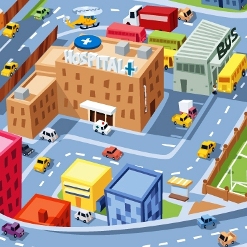- You are here:
- Home »
- Restructuring
- » State of the Art
State of the Art
Over the years we have consulted a number of primary care facilities and made suggestions or at the very least, strong recommendations to help each organization increase profitability. The issue most hospitals struggle with is achieving  a balance between generating a profit and providing high quality patient care. One thing is often overlooked and that relates to vendor relationships and the cost of maintaining them. Processes can be streamlined but not many hospitals have stepped up to the plate and taken account of how each vendor fits into their processes so that they actually contribute to the hospital’s profitability and efficiencies at the same time. I remember sitting with the president of a large medical products company, who said, “We’re getting very good at mowing the lawn around the tower of Piza, without ever asking why the tower is there or even why it is leaning.”
a balance between generating a profit and providing high quality patient care. One thing is often overlooked and that relates to vendor relationships and the cost of maintaining them. Processes can be streamlined but not many hospitals have stepped up to the plate and taken account of how each vendor fits into their processes so that they actually contribute to the hospital’s profitability and efficiencies at the same time. I remember sitting with the president of a large medical products company, who said, “We’re getting very good at mowing the lawn around the tower of Piza, without ever asking why the tower is there or even why it is leaning.”
| Hospital directors can increase profitability usually by more than 10% simply by initiating Customer operating partnerships with their top vendors. |
| – Dr. T. Box |
At one point, several hospitals asked this vendor to consider becoming a prime vendor, a “master supplier” who channels supplies from a variety of sources through one warehouse into the hospital’s receiving dock with consolidated invoicing. The president assembled a small team and asked them to follow the supplies downstream from the hospital receiving dock, to the points of patient consumption in several large hospitals. The team developed a systematic channel map and noticed a very disjointed, redundant supply channel. In the first segment, the company received hospital orders, picked the supplies, packed them, shipped them to the hospital, and invoiced for them. In the second segment, the team saw the mirror image once the supplies reached the hospital: The hospital issued the orders, received the supplies, unpacked the boxes, put the supplies away in the stockroom, and paid the invoices. In a third segment, the hospital wards ordered from the stockroom and put away the supplies. The conclusion drawn was that the materials management organizations were costly, but they also found very large pockets of hidden costs in areas such as nursing. When the team looked into these findings, the hospital personnel had a difficult time accepting the actual cost. They found that the total cost of a “delivered” product at the patient’s bedside was about $5.00, contrasted with the $1.00 sales price at the hospital dock. Of the $4.00 increment, the internal hospital supply chain costs comprised about half, while the other half represented other internal factors.
A startling new perspective emerged: Over 80 percent of the business was outside the company’s traditional business definition.
The company defined the boundary of its supply chain as the hospital receiving dock, and had always assumed this business definition. New communications and computer technologies, however, had given it the capability to extend that boundary far into the Customers’ operations for their mutual benefit. The net result is that processes in the hospital were addressed to allow for less expensive delivery and more efficient use of hospital resources to help increase profitability. Without the vendor’s input, this insight into potential cost savings would not have made it into board level discussions and thus action that helped the hospital in the above example increase their bottom line by more than 14% last year. All thanks to the state of the art technology implemented by a company in the medical products supply chain. Do they sell more products to hospitals like this today? No question was the most recent response we received when we followed up with our report. If you are curious about what we recommended to the hospital board, the answer can be summed up in a single phrase: A stockless sytem. Below are a few of the immediate benefits they were able to realize.
Cost reductions. The stockless system created large cost reductions for both channel partners. The hospitals eliminated several steps in the supply chain, and greatly reduced their inventory levels. Valuable space was released, and hospital personnel were redeployed into patient care. The vendor gained large, unexpected operating benefits because the stockless system eliminated the previously erratic hospital order pattern. Moreover, the business unit was now being paid to take and process the orders that were previously processed by the company’s customer service department.
Sales increases. The company’s sales increased dramatically, even in highly-penetrated accounts. This increase was directly driven by (a) the operations-to-operations relationship that formed between the head nurses on the wards and the company ward coordinators, who were personable lead hands from the warehouse, not sales reps; and (b) a near perfect service level allowing sales reps to focus on selling new products, rather than on solving supply problems.
CEO relationships. The division president was able to establish close working relations with the CEOs of the major hospitals because The system involved large savings and major changes. Several important new joint business initiatives resulted from these dialogs.
Competitive advantage. The company developed immediate strategic advantage over its competitors, enabling it to secure the largest, most profitable accounts. This occurred because Customers became evangelists in support of the new system, they established a proven track record for performance and published it and both companies committed resources to establish operations-to-operations relationships. Once the vendor established this new way of doing business, its competitors could not easily follow. Now that is what I call state of the art.
